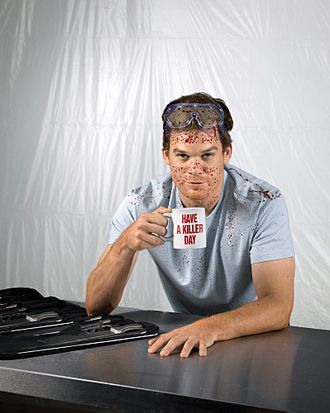Photo: Copyright: Showtime 2011
Dexter returns for its sixth season on Sunday, and with it comes the requisite gore deftly contrasted with the brutal sunshine of Miami. Some things never change! But some things really, really do. Like Dexter. Over the course of the series, he’s gone from stone-cold sociopath to slightly-less-cold lovable vigilante. Whatever moral ambiguity the show used to embrace — is it okay to … root for a murderer? — is gone, replaced with a strange certainty (definitely root for this murderer!) that takes a lot of the creepiness away from the show. How did Miami Metro’s favorite blood-splatter analyst go from his pas de deux with the Ice Truck Killer in season one to trying to get his son into a prestigious nursery school in season six? By following this plan to go from scary serial killer to soft suburban dad in these seven easy steps!
Dexter was never better than its first season, and that’s because Dexter never had a better foe than the Ice Truck Killer. Once you’ve been in a demented cat-and-mouse game with your long-lost brother with whom you share a twisted predisposition for dismemberment and trophy-keeping, how can anything else even come close? Ever since Rudy, Dexter’s been getting softer because he knows he’ll never have any other real competition.
Remember Doakes? Don’t worry — neither does anyone else on this show. But early on, Doakes was essential because he was the only person who seemed like he had any effect on our killer. Dexter’s surrounded by people who are pretty closed off about their emotions, but Doakes was easy to read and thus a solid model for someone trying to mimic or eventually adopt authentic feelings. Plus, it’s easy to blend in next to someone that expressive. If you regularly stand next to someone who’s screaming “I’m on to you, motherfucker!” your stunned silence seems completely normal.
In season one, Dexter seemed frequently puzzled by his surroundings, totally put off by other people’s actions, and unable to find meaning in their habits. Fortunately, he was able to avoid such confusing unpredictability by surrounding himself with some of the most consistent, routine-building people around, particularly Deb. No one has ever thought, Gee, I wonder what Deb will do? Because she will reliably: curse loudly; make dull observations (“it’s like he wanted us to find her”); curse again; fall for the wrong guy; be physically endangered; grieve that guy’s inevitable death; and then do it all over again. Every season. Like skinny, potty-mouthed clockwork.
Photo: ©Showtime 2009
One of Stanley Kubrick’s master moves in The Shining was casting Shelley Duvall as Wendy Torrance. She can scream pretty loud, but she’s so grating and vacant that when Jack Nicholson tries to ax-murder her, there’s a part of you that’s rooting for him. It was this same psychology that made Dexter’s early callousness toward his girlfriend (later wife) Rita easier to understand, and her eventual death completely easy to deal with. Rita’s constant whining, irritating children, vengeful ex, and need to fix everything through Even More Talking made her Dexter’s get-sympathy card from the get-go (aw, man, poor guy’s girlfriend is the most annoying person in the whole world). And when she was murdered, it meant Dex could bask in even more kindness and care from those around him. Let that nonstop emotional support work its magic!
Even the non-murderous among us sometimes see aspects of ourselves reflected in our partners or friends, and when those reflections are unflattering, it gives us pause to reflect. Dexter learned how to connect with other people by peering into the
souls of some of Florida’s true loony birds, and in the case of Lila, those reflections were really unflattering. With Miguel Prado, Dexter learned that he couldn’t create someone else in his image — and that it was dangerous to even try. Instead, Dexter wound up changing himself instead of trying to groom a new buddy.
Literally. Stalk and then murder them until the idol worship is really out of your system. The romance is officially dead! Now you can go about your murders with more of a to-do-list attitude and less of a hero complex.
You’re almost there! Where you once put all your passion and appetite for murder, swap in someone else’s appetite for revenge. Dexter started out killing killers not from a sense of ingrained justice but because he wanted to live up to his father Harry’s code. By season five, though, that want neatly overlapped with Lumen’s revenge fantasy, and suddenly Dexter’s dark passenger was driving directly toward empathy. Once Dexter could act on someone else’s murderous desires, he fell in love. Ta-da! It only took five seasons and dozens of murders, but Dexter officially grew a tiny shred of something resembling a heart.
Photo: ©Showtime 2010













